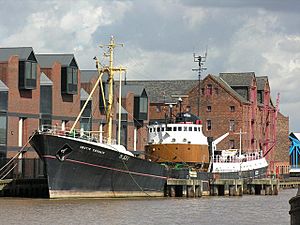Arctic Corsair facts for kids

Arctic Corsair in 2005
|
|
Quick facts for kids History |
|
|---|---|
| Name | Arctic Corsair |
| Owner | Boyd Line, Hull |
| Port of registry | Hull |
| Builder | Cook, Welton & Gemmell, Beverley |
| Yard number | 959 |
| Launched | 29 February 1960 |
| Out of service | 1993 |
| Renamed |
|
| Identification |
|
| Status | Museum ship |
| General characteristics | |
| Class and type | Diesel side-fishing trawler |
| Tonnage | 764 GRT, 256 NRT |
| Length | 187.1 ft (57.0 m) |
| Beam | 33.6 ft (10.2 m) |
| Installed power | 1,800 bhp (1,300 kW) |
| Propulsion | 6-cylinder Mirrlees Monarch diesel engine |
| Speed | 15 knots (28 km/h) |
The Arctic Corsair (H320) is a famous deep-sea trawler built in 1960. This ship was later turned into a museum ship in 1999. It is currently docked at Alexandra Dock in Kingston upon Hull, England. Soon, it will move to a new permanent home in the city's Museums Quarter. On board, visitors can learn about Hull's important deep-sea fishing history.
Contents
About the Arctic Corsair
The Arctic Corsair is the last remaining "sidewinder" trawler from Hull. Sidewinder trawlers were fishing boats that dropped their nets from the side of the ship. This type of vessel was very important for Hull's fishing industry. The ship was built in 1960 by Cook, Welton & Gemmell in Beverley. It was the second diesel-powered trawler made for the Boyd Line company. The Arctic Corsair was designed to handle the tough weather conditions found in the Icelandic fishing areas. Its hull was built with rivets, which are strong metal fasteners, instead of being welded.
History of the Trawler
Early Years and Incidents
In September 1967, the Arctic Corsair was damaged in a crash. This happened off the coast of Scotland when it hit an Irish coal ship called Olive in thick fog. The Arctic Corsair tried to reach the harbour in Wick but ended up stuck on the beach in Sinclair Bay. Luckily, it was later repaired and floated again.
In 1973, the ship set a world record! It brought in the largest amount of cod and haddock ever from the White Sea.
The Cod Wars Incident
On April 30, 1976, during a time known as the Cod Wars, the Arctic Corsair was involved in another incident. The Cod Wars were disagreements between the United Kingdom and Iceland about fishing rights. During one of these conflicts, the Arctic Corsair bumped into the Icelandic patrol ship Óðinn. This happened after Óðinn tried three times to cut the Arctic Corsair's fishing ropes. The captain, Charles Pitts, said that the Icelandic sailors were becoming more daring. With a hole below its waterline, the Arctic Corsair was temporarily fixed by the Royal Navy. Captain Pitts decided to sail home for full repairs. The ship was out of action for several months. Years later, in 2017, both ships, which are now museum ships, exchanged their bells. This was a friendly gesture to show cooperation.
Later Fishing Career
In 1978, the Arctic Corsair was changed to do "midwater trawling." This is a different way of fishing where nets are used in the middle of the water, not just on the seabed. In 1981, it was put out of service in Hull. However, in 1985, it was brought back and changed again for normal fishing. In 1988, its name was changed to Arctic Cavalier.
Becoming a Museum Ship

In 1991, a group called STAND, which works to preserve fishing history, started a campaign. They helped get money for Hull City Council to buy the trawler in 1993. Once purchased, the ship's name immediately went back to Arctic Corsair. It was then docked in the River Hull between Drypool Bridge and Myton Bridge to become a museum.
After being restored by trainees and volunteers from STAND, the floating museum opened to the public in 1999. STAND worked with the City Council to provide volunteers who help maintain the ship and give tours. Today, volunteers still run the museum, with support from Hull City Council. The Arctic Corsair is currently closed while it undergoes important restoration work.
In June 2018, it was announced that the ship would move to a dry-dock in September 2018. This was needed because of flood defense work happening on the River Hull. The move was delayed, but on August 4, 2019, the ship moved to a temporary spot in Alexandra Dock. On October 6, 2021, two tugboats moved it to Dunston's shipyard for restoration. The Arctic Corsair will eventually move to a new permanent home in the redeveloped North End Shipyard. This shipyard is part of the Hull Maritime City project and is located back in the Museums Quarter. Work on the shipyard's visitor center began in November 2022.
See also
- Middle-water trawler Ross Tiger, the last surviving vessel of the rival fleet across the Humber at Grimsby
- Viola (trawler) Middle-water traditional 'bridge-aft-sider' trawler. In derelict condition with hopes of regeneration.

